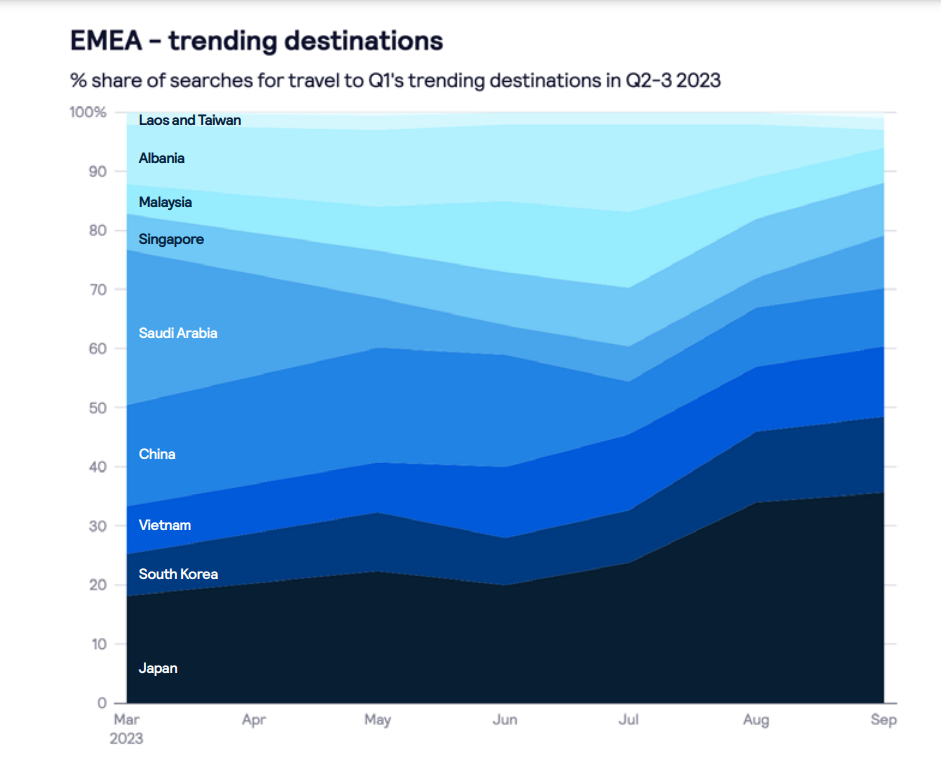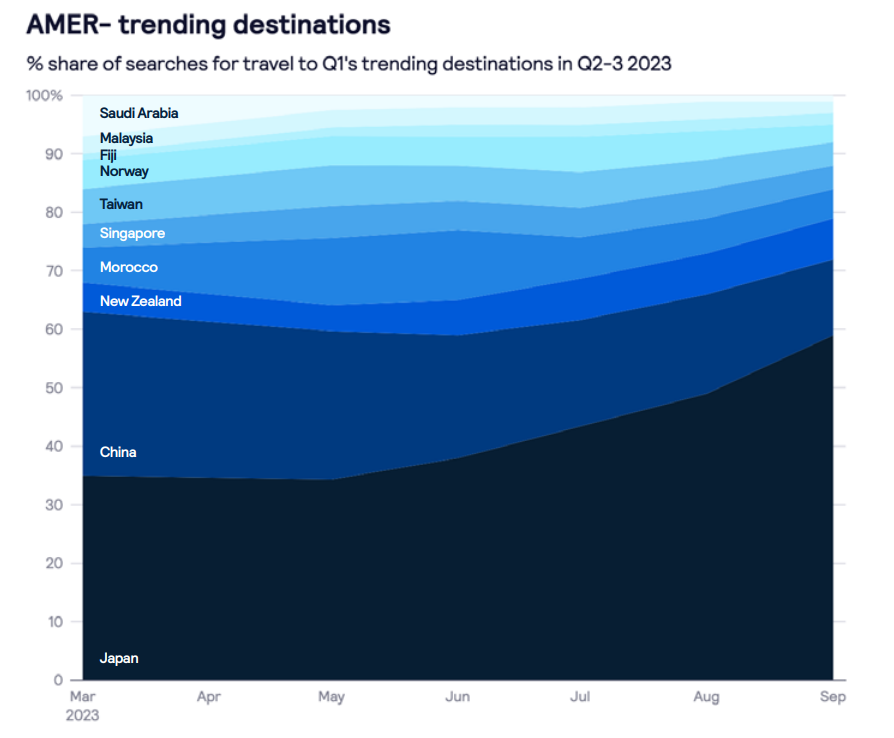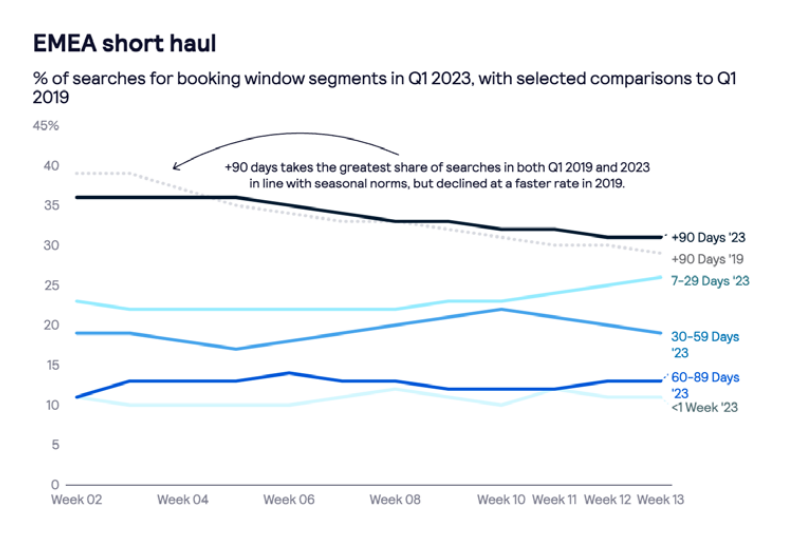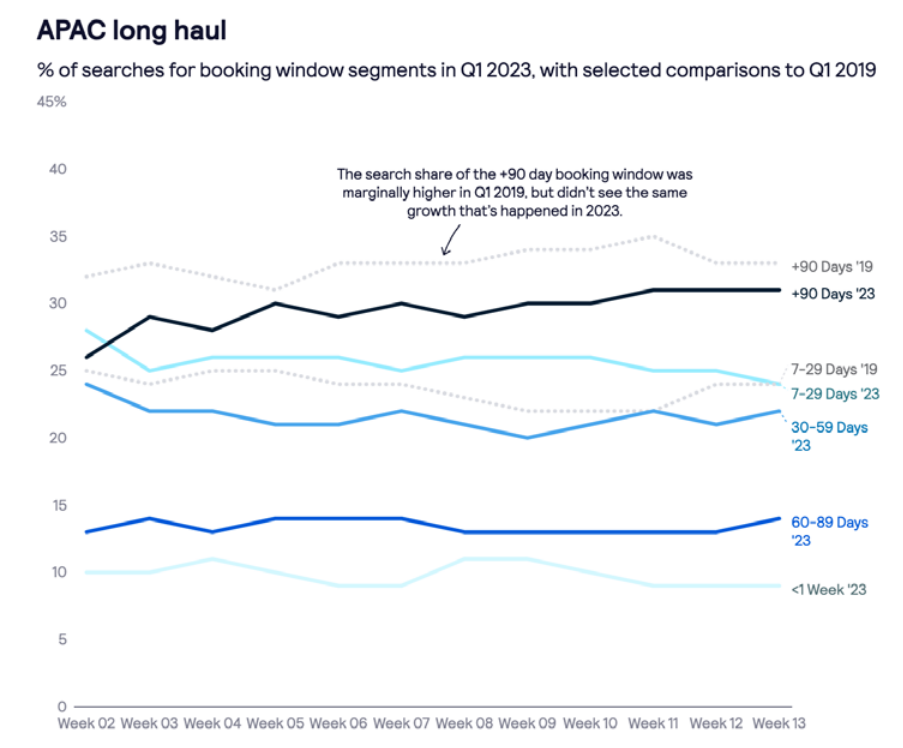With travellers feeling more confident again about booking long-distance trips, many destinations in the Asia-Pacific region are seeing a resurgence, from the neon lights and skyscrapers of Tokyo to the beautiful beaches of Phuket and the maze of narrow alleyways of Hanoi’s Old Quarter.
The report, from travel marketplace Skyscanner, looked at flight search and booking data across the Americas, Asia Pacific, Europe, the Middle East and Africa to explore how travelers will plan and book trips over the next six months.
People are booking long-haul trips more than 90 days in advance, returning to pre-pandemic levels. Additionally, the report states that search share has also returned to pre-pandemic seasonal norms.
“Globally, more travelers are using Skyscanner than ever before,” said Mike Ferguson, destination marketing director for the Trip.com Group-owned brand, which averages more than 100 million travelers visiting the platform each month.
Further indications of flexible search patterns
According to Skyscanner, over 50% of travelers are exploratory searches without a set date or destination in mind, with many looking for ideas and comparing dates and locations to find the best deal.
Previously, in a conversation with Skift, Airbnb co-founder and CEO Brian Chesky pointed out how millions of customers are taking advantage of the platform’s flexible dates feature, which essentially says, “I’d like to go anywhere during this date range – for a night, a weekend, a week, a month.”
The return of long-distance travel
Nick Hall, CEO of the UK-based Digital Tourism think tank, said the resurgence in long-distance travel globally presented destinations with a huge opportunity to attract high-value tourists despite tough economic times.
The main driver is airlines once again ramping up flight capacity.
According to the International Air Transport Association (IATA), international traffic on Asia-Pacific airlines increased 376% in January from the same month last year, reaching 56% of January 2019 levels.
The January figure was by far the highest year-over-year rate in the region, although from a very low base as travel bans were still in place across much of the region.
The region’s capacity factor increased to 167 percent and load factor increased 36.6 percentage points to 83 percent, the highest of any region in the world.
Popular destinations
Eight of the top 10 most popular destinations for tourists around the world are in Asia, with Taiwan topping the list, followed by Japan and Laos.

 Source: Skyscanner
Source: Skyscanner
Despite being the most popular travel destination, Taiwan has a small relative share of searches, with Japan accounting for the largest share, followed by South Korea and Vietnam.
Skyscanner noted that all three countries are benefiting from direct flights and improved air connectivity.
Saudi Arabia and Albania were the two countries outside of Asia that saw the largest year-over-year search growth in Q1.
While Europe remains a popular region for travelers from the Americas, Asia Pacific holds seven of the top ten most popular destinations, with Asian countries taking the top five spots.
China is the most popular destination, followed by Japan and Taiwan.

 Source: Skyscanner
Source: Skyscanner
For Asia Pacific travelers, seven of the top 10 popular destinations are in the region, with Taiwan, Laos and Japan recording the strongest year-over-year growth in the first quarter.
Laos, in particular, has experienced a resurgence thanks to the introduction of new routes by international and regional airlines, as well as growing demand from travelers seeking more unique and off-the-beaten-path destinations.
In Q2 and Q3, Japan, Thailand and Vietnam were the most popular destinations among travelers, accounting for more than two-thirds of trending search volume.
Reservation slots are expanding
The report found that travellers in Europe, the Middle East and Africa are booking their summer holiday tickets two to three months in advance, while those in Asia Pacific are booking at the last minute or well in advance.
In the first quarter of this year, most domestic travel bookings in Europe, the Middle East and Africa were made within a seven to 29 day window. Summer vacation planning saw the booking window extend even further with a 50% increase in holidays booked 60 to 89 days in advance.
As of the end of the first quarter, booking windows of more than 90 days still accounted for the highest share (31%) of travel to short-haul destinations from Europe, the Middle East and Africa.

 Source: Skyscanner
Source: Skyscanner
This confidence is also reflected in bookings for long-haul travel, particularly to the Asia Pacific region, where the proportion of booking windows greater than 90 days increased 11 percentage points in the first quarter to 40 percent.
Asia Pacific travel booking windows remained fairly constant during the first quarter as travelers preferred shorter booking windows for domestic travel.
But as travel restrictions ease, people are making both last-minute and longer-term bookings.
Booking windows of 90 days or more increased 55 percent for short-haul trips, while bookings of less than a week increased 22 percent, according to the Skyscanner report.
Additionally, booking windows for long-haul travel have extended significantly as Asia Pacific travellers become more confident in traveling and planning longer distances.

 Source: Skyscanner
Source: Skyscanner
In the Americas, booking windows are returning to seasonal norms as travelers plan domestic and short-haul trips at least two months ahead.
For more details, check out the latest results from Skift Research’s Travel Tracker, due to be released on Tuesday.

